NASA has held a competition for 3D-printed habitats for the Mars expedition for a while now. Finally, it has decided on the five winning designs.
If you don’t know, the On-Site Habitat Competition required the competitors to design a sustainable shelter for a crew of four astronauts using 3D printing technology which would withstand the conditions on Mars.
The challenge wasn’t just to come up with a great design, but to also offer solutions concerning the transport of the material from Earth to Mars and the differences in atmosphere and landscape on Martian soil.
The first place was awarded to team Zopherus from Arkansas. They proposed a spider-like lander that would scan its surroundings before selecting a desirable area. It would then gather ice, calcium oxide and martian aggregate with the help of autonomous robots in order to feed the 3D-printer.
The entire printing process would happen within the pod and once completed, the lander would simply lift its legs to reveal the structure and move to the next location to build a new one, hence creating series of rooms.
The rooms would have large windows to capture light and transfer it to hydroponic gardens which in turn, would help with the production of oxygen.
The second place in the competition was occupied by the SpaceFactory team.
Their design was an egg-shaped structure with a double shell system. This would help it deal with the internal atmospheric pressure and the gravitational structural stress which occurs in the Martian environment.
Just like the Zopherus design, SpaceFactory’s Marsha would be built using materials from the Martian surface, which would make NASA not depend on rockets to transport materials from Earth.
Finally, the third place was occupied by the Kahn-Yates team. Their spacious design offered a lot of light and also aimed to minimize the impact of the Martian dust storms. The habitat would arrive to Mars pre-fabricated, on a space-faring module that would split on landing, leaving the pre-fabricated core on the ground.
A five-axis print arm would print out a shell, while other nozzles would print high-density polyethylene layers on both sides of it.
Alongside the three main winners (whose projects you can see in the video above), other two teams were also awarded, the SEArch+/Apis Cor team and the Northwestern University, both of them coming up with less roomy but practical approaches.
Credit: NASA Marshall Space Flight Center / YouTube
The teams now have $100,000 to split between them. Next, they will have to build their projects. They are expected to have a working 3D printer ready by early 2019 which should be able to create a 1:3 scale model of the habitat they presented.
Whoever wins will be holding the big prize of $2 million in their pockets, which will help them turn their habitat into a reality.
Follow TechTheLead on Google News to get the news first.
















